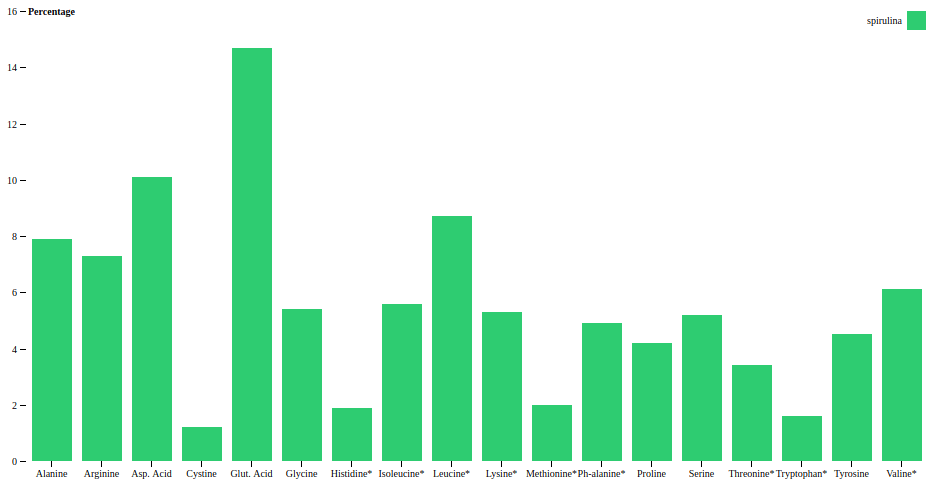I’ve plotted a typical spirulina amino acid profile below, the essential amino acids have a star beside them (*).
This plot was created with our amino acid profile comparison tool.
Table of Contents
Complete List of Spirulina’s Amino Acids
In case it’s a bit tough to see the names on the chart, here’s the data in table form instead.
| % of total amino acids | |
|---|---|
| Alanine | 7.9 |
| Arginine | 7.3 |
| Aspartic Acid | 10.1 |
| Cystine | 1.2 |
| Glutamic Acid | 14.7 |
| Glycine | 5.4 |
| Histidine* | 1.9 |
| Isoleucine* | 5.6 |
| Leucine* | 8.7 |
| Lysine* | 5.3 |
| Methionine* | 2 |
| Phenylalanine* | 4.9 |
| Proline | 4.2 |
| Serine | 5.2 |
| Threonine* | 3.4 |
| Tryptophan* | 1.6 |
| Tyrosine | 4.5 |
| Valine* | 6.1 |
Is Spirulina a Complete Protein?
There are 2 things that determine if a protein source is a “complete” protein (defined by the WHO):
- The relative percentage of each essential amino acid group.
- The quantity of each essential amino acid compared to an RDA
Here’s a table that compares the relative percentage of essential amino acids in spirulina to minimum values for a complete protein:
|
Complete Protein (min %)
|
Spirulina (%) | |
|---|---|---|
| Histidine | 1.5 | 1.9 |
| Isoleucine | 3 | 5.6 |
| Leucine | 5.9 | 8.7 |
| Lysine | 4.5 | 5.3 |
|
Methionine+Cysteine
|
1.6 | 3.2 |
|
Phenylalanine+Tyrosine
|
3 | 9.4 |
| Threonine | 2.3 | 3.4 |
| Valine | 3.9 | 6.1 |
Based on those numbers, spirulina has the essential amino acid distribution required of a complete protein.
The only issue is how are you going to eat a lot of it? While seaweed is nutritious, typically we only sprinkle it on top of meals or have a few dried pieces of it.
A typical serving size is 7-10 grams. Now we need to compare the amount of each essential amino acid per serving of spirulina.
| RDA (mg fo 65 kg adult) | Mg in 10g of Spirulina | Servings Needed to Get RDA | |
|---|---|---|---|
| Histidine | 650 | 109 | 6.0 |
| Isoleucine | 1300 | 321 | 4.0 |
| Leucine | 2535 | 495 | 5.1 |
| Lysine | 1950 | 303 | 6.4 |
| Methionine+Cysteine | 975 | 181 | 5.4 |
| Phenylalanine+Tyrosine | 1625 | 536 | 3.0 |
| Threonine | 975 | 297 | 3.3 |
| Valine | 1690 | 351 | 4.8 |
While it’s an amazing amount for just 10 grams of a food, you have to eat quite a few servings of it if you had to live on it. But you could if you had to.
The limiting amino acid is lysine. In order to meet lysine’s RDA, you would need to consume 64 grams of dried spirulina.
Is that realistic for most people? Probably not.
But it’s a great protein source to combine with others, just don’t fully rely on it for all your protein needs.
It depends on what definition you’re going by, but by most definitions, spirulina is a complete protein.
Overall Summary of Spirulina’s Amino Acid Profile
Spirulina has a great, balanced profile, about as good as quinoa’s amino acid profile. It is considered a complete protein by most, as it has all the essential amino acids in significant amounts.
To get a sense of how it compares to animal protein sources, let’s compare it to whey.
The relative level of each amino acid is similar as in whey, except for a few exceptions. Spirulina has:
- Relatively high levels of arginine and glycine
- Relatively low levels of threonine and lysine
- A slightly lower amount of glutamic acid
Remember that threonine and lysine are essential amino acids, so that’s not great for spirulina. But at the same time, they’re still comparable protein sources overall, just whey’s maybe a tiny bit better.
What Can You Eat Spirulina With?
You can add spirulina to just about liquid-based food, and you’ll barely taste it (or it may make the taste better).
Most people add spirulina to:
- Smoothies
- Hummus
- Salad dressing
- Any other food sauces
- Homemade granola bars
- Popcorn (if you really like the taste of it)
If you have any other creative ways of eating it, feel free to share them with others in the comment section below.


Thank you! I am curious about plant based sources such as spirulina as a glycine source. This information is exactly what I was looking for.